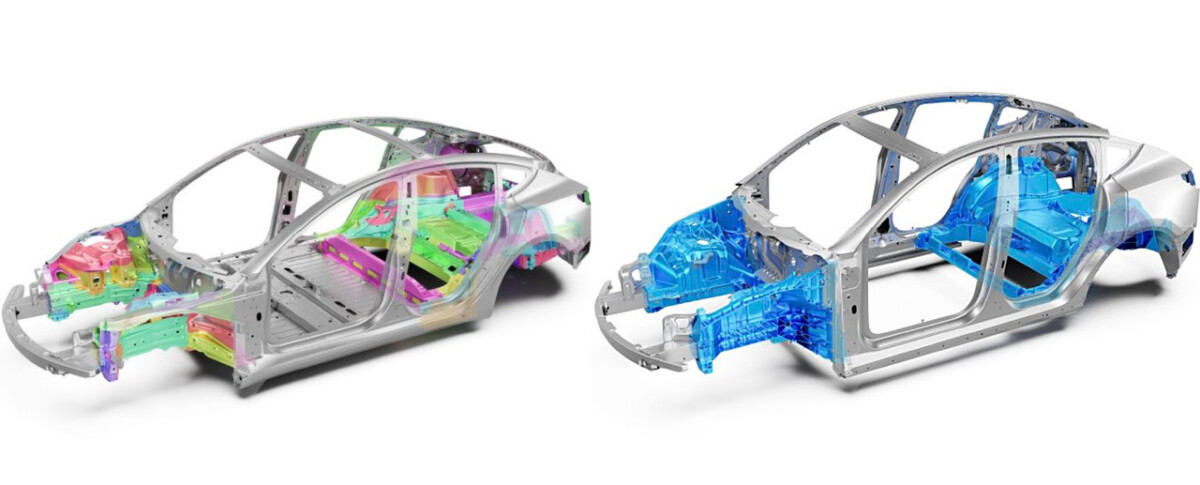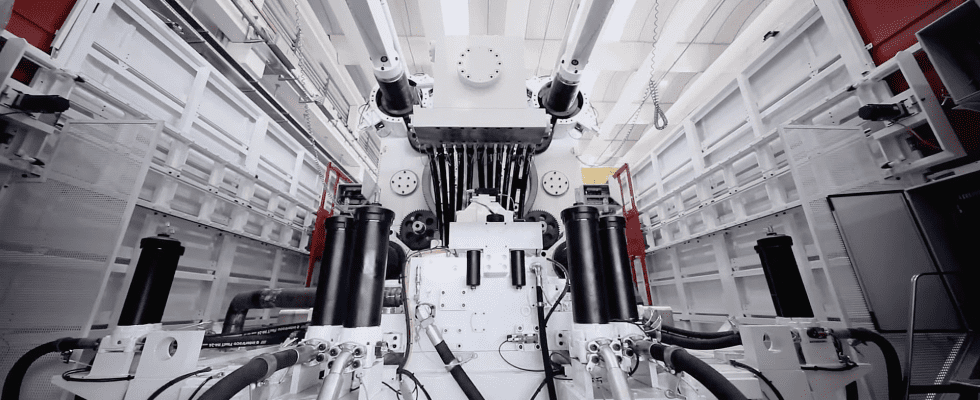Tesla has more than once shaken up certain “traditions” of the automobile industry, with methods and processes that can today be described as “revolutionary” since certain other manufacturers intend to take inspiration from them. This is particularly the case of the Tesla Giga Press, a manufacturing process hitherto unprecedented in the automotive landscape. The future Tesla Model 2 should benefit from this, to sell from 25,000 dollars.
Marketing, distribution, price management, charging eco-system, on-board technologies… In the space of a little over a decade, Tesla has managed to shake up the codes of the automotive industrywith approaches that are sometimes very different from those of “traditional” manufacturers.
If most newcomers to the automotive industry are on a drip from large groups, this was not the case for Tesla, which steered its boat as it saw fit, not without money of course, but with the intention of partly revolutionizing the area.
It is clear that today, the results are there, with sales records that continue to fall and large groups that intend to “draw inspiration” from the Tesla model in many respects. fun factsRecently, engineers at Toyota, renowned as the big names in the auto industry, recently called the Model Y a “work of art” in terms of design.
And if the Teslas do not necessarily seem to evolve over time, in reality, a Model Y produced three years ago is almost no longer the same as a Model Y produced today. With mass production, the American firm had to review more than one of its production processes, and one of its latest “innovations” is undoubtedly the most important and interesting of recent years. Her name ? The Giga Press.
The Tesla Giga Press, what is it?
Behind this name straight out of a science fiction film hides a unique technology in the world in the automotive industry. The Giga Press is not “a machine”, but a “series of machines” for aluminum die-casting.
The Giga Press is not made by Tesla, but by Idra Group. It is a manufacturer of die-casting machines, founded in 1946 in Brescia, Italy, and the company stands out for producing the largest high-pressure die-casting machines in the world.
Our huge casting machines enable us to make full-size cars the same way toy cars are made ✌️ pic.twitter.com/pWvW5Ovufo
—Tesla (@Tesla) July 25, 2022
The numbers from the Giga Press are quite impressive. Each machine weighs between 410 and 430 tons and the clamping force is between 55,000 and 61,000 kilonewtons. To make a Tesla Model Y in a Giga Press for example, 80 kilos of aluminum molten at 850°C are injected into the mold of the cold room at 60 to 100 m/s.
The cycle time is between 80 and 90 seconds. A quick calculation therefore allows us to say that Tesla manages to produce 40 to 45 molds per hour, i.e. approximately 1,000 moldings per day with a single press.
What does it change ?
The Giga Press is fairly new technology for Tesla. Indeed, the American manufacturer was the first to use this technology when the Gigafactory arrived in Berlin, Germany, the first for Tesla in Europe and the fourth worldwide. The Berlin Gigafactory is expected to eventually produce approximately 500,000 vehicles per year.
But what does this actually change? If you follow the news around Elon Musk, the leader likes simple, quick and efficient things. And that’s generally how we could summarize the Giga Press, even if everything is not perfect, but we will come back to it below.
The Giga Press obviously allows faster manufacturing, with a more rigid and less heavy structure. This allows the manufacture of the chassis of a Tesla in three main elements: the aluminum alloy front and rear modules, plus the central floor. This also makes it possible to eliminate the assembly of at least 70 parts and, above all, it avoids the problems of sealing and welding points between the different parts.
From a technical point of view too, it changes a lot of things, and well beyond what one might think. Fewer parts also means less weight. Less weight also means lower consumption, therefore increased autonomy and, consequently, this does not require the addition of new battery cells to increase autonomy. According to figures put forward by Tesla, a structure made with the Giga Press allows a reduction of 10% on a Tesla Model Y and an increase in autonomy of 14%.

Can this concept be extended to other manufacturers?
Why did it take so long for a manufacturer to take an interest in this new production system? When traditional manufacturers invest in the renewal of their range and research and development, in particular concerning electromobility and driving aid technologies, on the side of Tesla, there is no “transformation” to operate in range at the moment since the cars are generally in tune with the times.
Tesla is therefore focusing on other areas, starting with its production process, which must keep pace with ever-increasing demand. If the European manufacturers that we all know have not yet really expressed interest in this system, the concept of Giga Presse is gaining popularity with the automotive industry.
And who cares? Chinese manufacturers of course. Indeed, like Tesla, most are quite “new” in the automotive landscape, and everything is still to be done for them. To produce quickly and efficiently, Giga Press technology is therefore an interesting solution.
As stated above, on the side of the European manufacturers, there is no rushing to the gate, except Volvo, which seems to be interested in this manufacturing process. But remember, however, that Volvo is under the bosom of the Chinese giant Geely, which intends to extend its empire well beyond the Asian market.

Why are some builders skeptical?
If traditional manufacturers are not scrambling to adopt this system, it is because there are bound to be disadvantages. As stated above, this requires a fairly colossal investment in terms of engineering, on the one hand to develop cars adapted to this production system, and with the synergies between the different brands of the different groups, it is much more than a simple factory or a simple structure that should be reviewed, but almost the entirety of a range and a production process.
And obviously this at a cost, and in a context where manufacturers are renewing their range to go electric, budgets related to investments are concentrated mainly at this level.
But that’s not the only problem. And besides, this is probably not the main problem for traditional manufacturers. Several questions arise such as, for example, the type of repair to be implemented on the chassis in the event of a vehicle accident. Because by drastically reducing the number of parts, it gives us several large parts, more exposed, and therefore more expensive to replace (if possible!) rather than several “small” parts to replace in the event of a minor incident.
There are also problems in terms of logistics that arise, although in the case of Tesla this is not necessarily true since the factories have been designed differently and group together practically the entire production process within a same establishment.

This is not the case for large groups, where sometimes such and such a part is made in such and such a place, in several different factories, to then be assembled again in another factory. If manufacturers do not centralize their production process, then transport costs will literally explode.
Imagine: Volkswagen introduces a Giga Press in China, which produces parts for an SUV assembled in Europe. The cost of transport to transport a part of about 100 kg and with dimensions of 600 x 1000 x 1500 mm (taking the example of the Tesla Model Y) will skyrocket the costs of manufacturing a car, which will obviously affect the final price of the car.
Tesla can afford to use such a solution only because everything is done on site and transport costs are kept to an absolute minimum. Its factories are also newer than those of other manufacturers and have been designed to accommodate these Giga Presses. They are not easy to integrate and existing factories do not necessarily have sufficient space to accommodate such “buildings”, and the robots or traveling cranes that accompany them.
We should also specify that we are at the beginning of the Giga Press within the automotive industry. Manufacturers do not yet have enough perspective to know with certainty whether these machines have, over the long term, a good rate of return, and whether their maintenance is also easily manageable. Because we imagine that a Giga Press is down, and it’s a whole factory that is paralyzed and not just a part.
Undoubtedly, the future Tesla Model 2 will benefit from this manufacturing process to bring prices down, and reach the 25,000 dollars promised by Elon Musk.
To follow us, we invite you to download our Android and iOS application. You can read our articles, files, and watch our latest YouTube videos.
